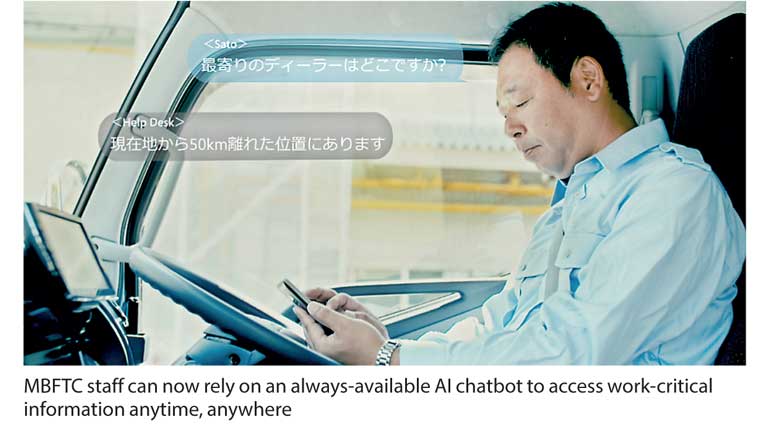Sunday Feb 23, 2025
Sunday Feb 23, 2025
Wednesday, 10 January 2018 12:00 - - {{hitsCtrl.values.hits}}

 By Ralph Haupter
By Ralph Haupter
If the history of human advancement has taught us one thing it is this: genuine step-change progress does not occur because of a single technology breakthrough, but a combination of multiple complementary factors coming together at the same time.
The Industrial Revolution, which began in the UK around 1760, was driven by an amalgamation of steam power, acceleration in iron production and the development of the first machine tools.
Similarly, the PC revolution of the early 1970s was the outcome of simultaneous advancements in micro-processing, memory storage, software programming and other factors.
Now, as we enter 2018, we are at the cusp of a new revolution, one that will ultimately transform every organisation, every industry and every public service across the world.
I’m referring, of course, to Artificial Intelligence – or AI - and I believe 2018 is the year that this will start to become mainstream, to begin to impact many aspects of our lives in a truly ubiquitous and meaningful way.
AI: Over 65 Years
in the making
The concept of AI is not new. In fact, it stretches back to 1950 when early computing pioneer Alan Turing famously posed the question “Can Machines Think?” and it would be another 6 years, in 1956, before the term “artificial intelligence” was first used.
So it has taken nearly 70 years for the right combination of factors to come together to move AI from concept to an increasingly ubiquitous reality. And there are three innovation trends driving that right now.
nThe first is big data. The explosion of Internet-connected devices, sensors and objects has expanded exponentially the amount of data the world is now producing. In this increasingly digital era, data is the “new oil” – a source of value and sustainable competitive advantage.
nThe second factor is ubiquitous and powerful cloud computing. Today, anyone with an idea and a credit card can access the same computing power that, traditionally, only global multinationals or governments have possessed. Cloud computing is democratising technology and accelerating innovation.
nThe third factor driving AI capabilities is breakthroughs in software algorithms and machine learning that can identify sophisticated patterns implicit within the data itself. If data is the new oil, machine learning is, perhaps, the new combustion engine.
So, it is this combination of powerful industry trends, all maturing at the same time, that is accelerating – and democratising – AI today.
AI everywhere
My colleague Harry Shum, who leads our AI & Research Group, refers to the way in which AI will impact our lives as an “invisible revolution”. What he means is that, increasingly, AI will be everywhere—powering your online recommendation engine, acting as a virtual assistant chatbot for your bank account or travel agent, personalising your newsfeed or guarding your credit card against fraud. AI will be more pervasive – and yet less invasive – than any previous technology revolution.
In particular, AI will be embedded seamlessly into existing, well-established products and services to enhance their capabilities. Let me share a simple example of how AI is helping me work more effectively today. I travel frequently and am often required to present to multinational, multilingual audiences during business trips across Asia Pacific. Now, with a small piece of AI technology called Microsoft Presentation Translator, I can help overcome any language barriers as PowerPoint can show real-time subtitles in more than 60 languages, simultaneously as I speak, during my presentations.
In business, AI will be used by most companies for at least some part of the value chain either in research and development, design, logistics, manufacturing, servicing or customer engagement. In fact, leading IT industry analyst IDC believes that by 2019, 40% of digital transformation initiatives globally will be supported by AI capabilities1.
And you do not need to be a start-up or hi-tech company to embrace the possibilities, just have the vision and commitment to make it happen. Take, for example, Mitsubishi Fuso Truck and Bus Corporation (MFTBC), an 85-year-old Japanese auto manufacturer, which has given itself just two years to become a “100% digital operation” – complete with cloud-based capabilities in AI, the Internet of Things (IoT), and Mixed Reality (MR).
One of the initiatives they have recently implemented is an AI-powered chatbot where all its 10,000 employees can access information and assistance they need in a faster, more intuitive and reliable way. This significantly reduces the time employees spend on learning the Intranet site navigation, searching for information or calling each other for help. The company is now planning to extend chatbot technology to boost customer services, productivity, and maintenance across the whole company.
AI in 2018
In this new year, I see four key AI developments happening over the next 12 months:
1.Mass adoption of AI starts from 2018: AI adoption is set to soar in 2018 and beyond when organisations start to see clear benefits being reaped by AI innovators such as MFTBC. IDC forecast that worldwide AI revenues will surge past $46 billion in 20202. Closer to home, AI investment in Asia Pacific is predicted to be grow to $6.9 billion by 2021, expanding rapidly by 73% (CAGR)
2.Ubiquitous Virtual Assistants: We will begin to see the adoption of broad-scale AI in the form of conversational AI chatbots in both consumer and business scenarios. In fact, Gartner predicts that by 2020 more than 85% of customer interactions with the enterprise will be managed without a human and AI will be the key technology deployed for customer service3.
3.Democratising data and decision-making: In a world where more data exists than ever before, the ability to deliver meaningful business insights from that data to the maximum number of relevant employees becomes of paramount importance. AI will be the key technology for making that happen by bringing together data from employees, business apps, and the world.
4.Building trusted foundations for AI: There will be increasingly more discussions at governmental and industrial levels to create formal governance and regulations in the usage of AI. We saw these discussions with the onset of eCommerce and the advent of cloud technologies. It is critical for transparent public-private conversations to take place as they will shape how AI can benefit economies and societies in a fair, transparent and trusted way.
The future of AI burns brightly and I see 2018 as the year that will establish a solid foundation for the mass adoption of this exciting and vital technology.
Footnotes
IDC, IDC Reveals Worldwide Digital Transformation Predictions, Nov 2017
2 IDC, Worldwide Spending on Cognitive and Artificial Intelligence Systems Forecast to Reach $12.5 Billion This Year, According to New IDC Spending Guide, April 2017
3 https://www.forbes.com/sites/ciocentral/2011/09/27/customers-dont-want-to-talk-to-you-either/#ff504bc70dcd
(The writer is President of Microsoft Asia and Corporate Vice President, Microsoft Corp.)
Discover Kapruka, the leading online shopping platform in Sri Lanka, where you can conveniently send Gifts and Flowers to your loved ones for any event including Valentine ’s Day. Explore a wide range of popular Shopping Categories on Kapruka, including Toys, Groceries, Electronics, Birthday Cakes, Fruits, Chocolates, Flower Bouquets, Clothing, Watches, Lingerie, Gift Sets and Jewellery. Also if you’re interested in selling with Kapruka, Partner Central by Kapruka is the best solution to start with. Moreover, through Kapruka Global Shop, you can also enjoy the convenience of purchasing products from renowned platforms like Amazon and eBay and have them delivered to Sri Lanka.
Discover Kapruka, the leading online shopping platform in Sri Lanka, where you can conveniently send Gifts and Flowers to your loved ones for any event including Valentine ’s Day. Explore a wide range of popular Shopping Categories on Kapruka, including Toys, Groceries, Electronics, Birthday Cakes, Fruits, Chocolates, Flower Bouquets, Clothing, Watches, Lingerie, Gift Sets and Jewellery. Also if you’re interested in selling with Kapruka, Partner Central by Kapruka is the best solution to start with. Moreover, through Kapruka Global Shop, you can also enjoy the convenience of purchasing products from renowned platforms like Amazon and eBay and have them delivered to Sri Lanka.